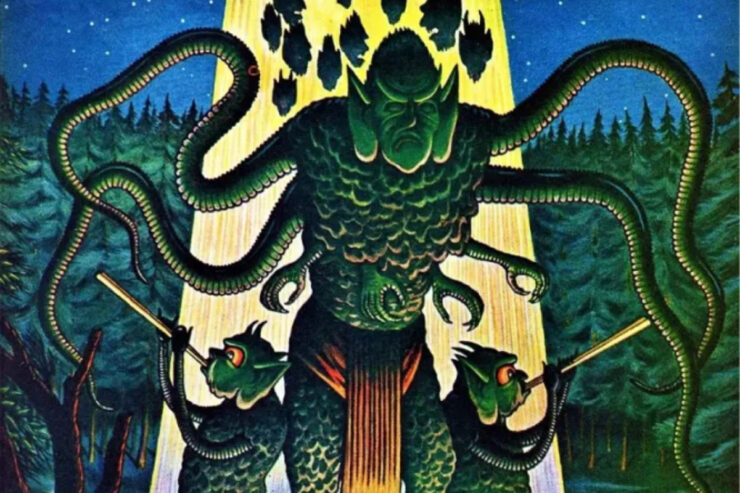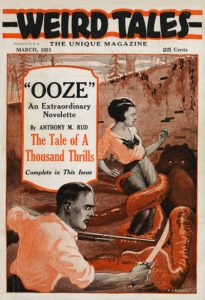 Weird Tales was the first periodical devoted to fantasy and the supernatural. Along with Hugo Gernsback’s Modern Electrics, The Electrical Experimenter, and Science and Invention, “The Unique Magazine” also provided a home for early science fiction.
Weird Tales was the first periodical devoted to fantasy and the supernatural. Along with Hugo Gernsback’s Modern Electrics, The Electrical Experimenter, and Science and Invention, “The Unique Magazine” also provided a home for early science fiction.
The magazine was the brainchild of Jacob C. Henneberger. With his partner, J. M. Lansinger, Henneberger published the very successful College Humor, along with its lesser companion, The Magazine of Fun. Wanting to expand into the growing pulp magazine field, the partners launched Detective Tales in September 1922, with author and journalist Edwin Baird serving as editor.
Hoping to spread their overhead costs over two pulps, Henneberger and Lansinger introduced Weird Tales about a half-year later. Its first issue was dated March 1923. Subtitled “The Unique Magazine,” the new pulp was meant to give a writer “free rein to express his innermost feelings in a manner befitting great literature.”
The early issues of Weird Tales were, in reality, filled with ghost stories and what the magazine’s editor — Edwin Baird — termed “gooseflesh fiction.” Far more interested in the publishers’ Detective Tales, Baird had little interest in fantasy and the supernatural. Add onto that uninspiring interior illustrations and bland, three-color cover art, low author rates and slow payments, and a high cover price when compared to other pulps, and one can understand why Weird Tales soon found itself in hock to its printer.
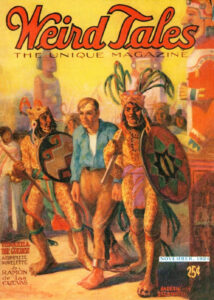 Convinced that a magazine dedicated to the strange and unusual could be successful, Henneberger sold his interests in College Humor, The Magazine of Fun, and the retitled Real Detective Tales to his partner. He plowed his proceeds back into Weird Tales. Baird stayed with the detective pulp, while one of his assistants, Farnsworth Wright, was named editor of “The Unique Magazine.”
Convinced that a magazine dedicated to the strange and unusual could be successful, Henneberger sold his interests in College Humor, The Magazine of Fun, and the retitled Real Detective Tales to his partner. He plowed his proceeds back into Weird Tales. Baird stayed with the detective pulp, while one of his assistants, Farnsworth Wright, was named editor of “The Unique Magazine.”
Although Edwin Baird had introduced Weird Tales readers to some of the magazine’s leading lights — Otis Adelbert Kline, H. P. Lovecraft, Frank Owen, Seabury Quinn, and Clark Ashton Smith — “The Unique Magazine” truly came into its own in late 1924 when Wright assumed the editorial reins. Although Lovecraft sometimes found Wright to be “a most bewilderingly capricious cuss!” it was Farnsworth Wright’s sense of the commercial pulp fiction market that kept the magazine afloat during some very challenging times.
With Wright at the helm, Weird Tales introduced readers to the work of Robert Bloch, Arthur J. Burks, Hugh B. Cave, Mary Elizabeth Counselman, August Derleth, Nictzin Dyalhis, Paul Ernst, Edmond Hamilton, Robert E. Howard, Carl Jacobi, Henry Kuttner, Greye La Spina, Frank Belknap Long, C. L. Moore, G. G. Pendarves, E. Hoffmann Price, Manly Wade Wellman, Donald Wandrei, Henry S. Whitehead, Jack Williamson, and others. And let’s not forget artists Hannes Bok, Magaret Brundage, and Virgil Finlay or the continued work of Kline, Lovecraft, Owen, Quinn, and Smith. It was Wright who published “The Call of Cthulhu,” “The Whisperer in Darkness,” and other classic works by H. P. Lovecraft. And though it was Edwin Baird who began buying the poetry of Clark Ashton Smith, it was Farnsworth Wright who launched the poet’s fiction career in 1928.
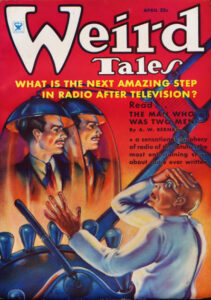 In addition to publishing some of the best fantasy and supernatural fiction of the twentieth century, Weird Tales — like the Munsey magazines — featured science fiction and scientific romances in its pages, offering tales of interplanetary expeditions, brain transference, death rays, lost races, parallel worlds, and more. Edmond Hamilton was its leading contributor of science fiction. With stories about alien invasions, space police, and evolution gone wild, the author became known as “world-wrecker” Hamilton.
In addition to publishing some of the best fantasy and supernatural fiction of the twentieth century, Weird Tales — like the Munsey magazines — featured science fiction and scientific romances in its pages, offering tales of interplanetary expeditions, brain transference, death rays, lost races, parallel worlds, and more. Edmond Hamilton was its leading contributor of science fiction. With stories about alien invasions, space police, and evolution gone wild, the author became known as “world-wrecker” Hamilton.
Other notable science fiction in Weird Tales included work by Austin Hall, Otis Adelbert Kline, Frank Belknap Long, C. L. Moore, Donald Wandrei, and Jack Williamson. And of course, H. P. Lovecraft spun his own unique style of science fiction in his tales of cosmic horror.
In late 1938, Weird Tales was sold to William J. Delaney, publisher of Short Stories. The magazine’s editorial offices were shifted from Chicago to New York, along with Farnsworth Wright. Dorothy McIlwraith, the editor of Short Stories, was named Wright’s assistant.
In declining health — due to Parkinson’s Disease — Wright stepped down from the magazine in early 1940. Now a bi-monthly, McIlwraith’s first issue as editor of Weird Tales was dated May 1940. Farnsworth Wright died not long after its release.
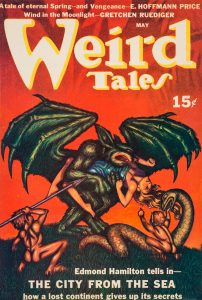 Like Wright before her, Dorothy McIlwraith continued to publish excellent fantasy and horror fiction, introducing readers to the work of Ray Bradbury, artist Lee Brown Coye, and author Allison V. Harding, as well as some of the early work of Fritz Leiber. Robert Bloch, August Derleth, Edmond Hamilton, Carl Jacobi, Seabury Quinn, and Manly Wade Wellman also continued to contribute significant work to “The Unique Magazine.”
Like Wright before her, Dorothy McIlwraith continued to publish excellent fantasy and horror fiction, introducing readers to the work of Ray Bradbury, artist Lee Brown Coye, and author Allison V. Harding, as well as some of the early work of Fritz Leiber. Robert Bloch, August Derleth, Edmond Hamilton, Carl Jacobi, Seabury Quinn, and Manly Wade Wellman also continued to contribute significant work to “The Unique Magazine.”
Facing increased competition, Weird Tales became a digest magazine with its September 1953 issue. One year later, the final number of its original run — the last of 279 issues — was published. It was dated September 1954 and featured a reprint cover by Virgil Finlay.
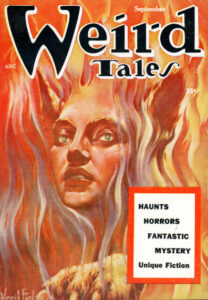 Nearly twenty years after its initial demise, “The Unique Magazine” became “The Magazine That Never Dies.”
Nearly twenty years after its initial demise, “The Unique Magazine” became “The Magazine That Never Dies.”
During 1973 – 74, Weird Tales was revived for four issues, edited by Sam Moskowitz. A paperback series lasting four more issues — edited by Lin Carter — appeared from 1981 to 1983. During 1984 – 85, Brian Forbes published two issues of what has become known as the California Weird Tales. The magazine was revived again in 1988 by George H. Scithers, Darrell Schweitzer, and John Gregory Betancourt. Since then, it has, more or less, been published continuously. The 367th issue was recently released. Learn more at http://weirdtalesmagazine.com/.
A century after its debut, Weird Tales continues to inspire writers, artists, film directors, and other creators in important ways. You can’t get much more “Unique” than that! That’s why PulpFest will be saluting “The Unique Magazine” at its 2023 conference. We hope you’ll join us from August 3 – 6 at the DoubleTree by Hilton Hotel Pittsburgh – Cranberry in Mars, Pennsylvania.
You can become a member of the convention by clicking the Registration button on the PulpFest website. And don’t forget to book a room.
The first issue of WEIRD TALES — dated March 1923 — featured cover art by R. R. Epperly. It is best remembered for publishing Anthony M. Rud’s “Ooze,” a story concerning a giant amoeba. The issue was edited by Edwin Baird.
Farnsworth Wright’s first issue of Weird Tales as editor was dated November 1924. It’s the magazine’s second four-color cover, following the “Anniversary Number” of May-June-July 1924. The cover art is by Andrew Brosnatch.
One of the changes that Wright instituted when he took over “The Unique Magazine” in the fall of 1924 was to increase the number of interior illustrations in each issue. According to Terence E. Hanley, writing in Tellers of Weird Tales, “Brosnatch illustrated every part of the magazine — covers, interiors, and “The Eyrie” alike — for the next year and more, sometimes singlehandedly. . . . Long after Brosnatch had left Weird Tales, his decoration for “The Eyrie” remained, even to the last issue, September 1954.”
Margaret Brundage created 66 covers for Weird Tales between 1932 and 1945, making her the most in-demand cover artist for the magazine. Only Virgil Finlay was a close rival. Despite contributing over five dozen covers to “The Unique Magazine,” her cover for Weird Tales for April 1935, seems to be the only one with a science fiction theme.
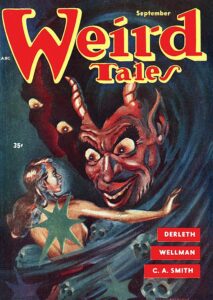 Beginning with the December 1939 number of Weird Tales, Hannes Bok contributed seven covers to “The Unique Magazine.” Pictured above is his cover for the May 1940, the first issue to be edited by Dorothy McIlwraith, who also served as the editor of Short Stories. Quite a few authors resented the promotion of McIlwraith to the editorial chair of Weird Tales, feeling that Farnsworth Wright had been forced out by the publisher. Truth be told, Wright’s health was increasingly precarious in 1940. He passed away on June 12 of that year.
Beginning with the December 1939 number of Weird Tales, Hannes Bok contributed seven covers to “The Unique Magazine.” Pictured above is his cover for the May 1940, the first issue to be edited by Dorothy McIlwraith, who also served as the editor of Short Stories. Quite a few authors resented the promotion of McIlwraith to the editorial chair of Weird Tales, feeling that Farnsworth Wright had been forced out by the publisher. Truth be told, Wright’s health was increasingly precarious in 1940. He passed away on June 12 of that year.
With increasing competition from digest magazines, paperback books, comic books, and more, Weird Tales was converted to a digest magazine with its September 1953 number. It labored on for another year, featuring a mix of reprint fiction and original stories. Three of its final four covers were also reprints, including the Virgil Finlay piece used for September 1954 number, its final issue. It was originally used as the cover art for the August 1939 Weird Tales.
Our final image is Weird Tales for September 1953, with cover by Jon Arfstrom. It is the first of seven digest issues of “The Unique Magazine.” The artist — who passed away on December 2, 2015 — was a guest of our convention that same year.
Our featured image is adapted from Matt Fox’s cover art for the November 1944 Weird Tales, edited by Dorothy McIlwraith. A cartoonist, illustrator, comic book and advertising artist, watercolorist, painter, and graphic artist, with lithographs, woodcuts, and etchings to his credit, Fox painted eleven covers for Weird Tales and also contributed interior illustrations to the magazine. A freelance artist, he also worked for Fiction House, Popular Publications, and other publishers, and later for Marvel Comics.
To learn more about the origins of Weird Tales, we highly recommend John Locke’s The Thing’s Incredible: The Secret Origins of Weird Tales. To learn more about ordering a copy, visit Off-Trail Publications. And for a video on “The Unique Magazine,” go to our YouTube Channel. While you’re there, please subscribe. We’ll be posting more videos there in the future.

